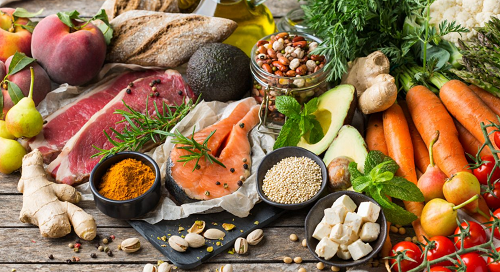
Happy Nutrition Month! This March, AFSPA encourages you to focus on your nutrition. Part of focusing on your nutrition includes making your plate, at meals, diverse and filled with the nutrients you need.
According to the 2020-2025 Dietary Guidelines for Americans, half of your plate should have fruits and vegetables. The other half should have grains and protein. Your plate should also include dairy. There are different ways to diversify your plate while maintaining a healthy diet. Let’s break down what should be included on your plate, and the ways to vary your foods.
Let’s start with what counts as a fruit. Any fruit or 100% fruit juice counts as part of the Fruit Group. Fruits may be fresh, canned, frozen, or dried. The amount of fruit you need to eat depends on age, sex, and level of physical activity, but normally varies between one and two cups each day.[1] Generally, one cup of fruit or 100% fruit juice, or ½ cup of dried fruit is considered 1 cup from the Fruit Group.[1]
So, why is fruit important to eat? It’s proven that people who eat more fruits and vegetables, as part of an overall healthy diet, are likely to have reduced risk of some chronic diseases. Most fruits are naturally low in fat, sodium, and calories, and none have cholesterol.[1]
Any vegetable or 100% vegetable juice counts as a member of the Vegetable Group. Vegetables may be raw or cooked; fresh, frozen, canned, or dried/dehydrated; and may be whole, cut-up, or mashed. Based on their nutrient content, vegetables are organized into 5 subgroups: dark green; red and orange; beans, peas, and lentils; starchy; and other vegetables.[1]
The amount of vegetables each person needs can vary between one and three cups each day. Generally, one cup of raw or cooked vegetables or vegetable juice, or two cups of raw leafy greens can be considered one cup from the Vegetable Group.[1]
Any food made from wheat, rice, oats, cornmeal, barley, or another cereal grain is a grain product. Grains are divided into two subgroups: Whole Grains and Refined Grains. Whole grains contain the entire grain kernel – the bran, germ, and endosperm.[1] Examples of whole grains include whole-wheat flour, oatmeal, whole cornmeal, and brown rice. Refined grains have been milled, a process that removes the bran and germ.[1] This gives grains a finer texture and improved shelf life. However, this process also removes dietary fiber, iron, and many B vitamins.[1] Some example of refined grain products include white flour, white bread, and white rice. Most refined grains are enriched. This means certain B vitamins and iron are added back after processing, but fiber is not added back.[1] Be sure to check the ingredient list on refined grain products to make sure the word “enriched” is included in the grain name.[1]
The amount of grains each person needs can vary between three and eight ounces each day and at least half of the grains you eat should be whole grains.[1] One slice of bread, one cup of cereal, or ½ cup of cooked rice or pasta can be considered as one ounce from the Grains Group.[1]
All foods made from seafood, meat, poultry, eggs, beans, peas, lentils, nuts, seeds, and soy products are considered part of the Protein Foods Group. The amount of protein each person needs can vary between two and six-and-a-half ounces each day.[1] One ounce of meat, poultry or fish, ¼ cup of cooked beans, one egg, one tablespoon of peanut butter, or ½ ounce of nuts or seeds can be considered one-ounce equivalents from the Protein Foods group.[1]
Although most people get enough protein, many don’t make lean or low-fat choices of protein foods. Fatty cuts of beef, pork, and lamb, regular ground beef, regular sausages, hot dogs, bacon; some lunch meats such as regular bologna and salami; and some poultry such as duck, are high in saturated fat.[1] Saturated fats raise “bad” cholesterol levels and increase your risk for coronary heart disease. Try your best to limit the amount of fatty meats you eat and to make lean or low-fat choices.
The Dairy Group includes milk, yogurt, cheese, lactose-free milk, and fortified soy milk and yogurt. Foods made from milk that have little calcium and high fat content, such as cream cheese, sour cream, cream, and butter, are not included in the Dairy Group.[1] One cup of milk, yogurt, or soy milk, or one-and-a-half ounces of natural cheese can be considered as one cup from the Dairy Group.[1]
Most individuals do not get enough dairy. Most individuals would benefit by increasing intake of fat-free or low-fat dairy, whether from milk, yogurt and cheese, or from fortified soy milk or yogurt. The amount of dairy foods you need each day depends on your age and can vary between 1 ½ to 2 cups for toddlers, 2 ½ cups for children under 10 and 3 cups for older children through adults.[1]
The Foreign Service Benefit Plan (FSBP) offers its members generous dietary and nutrition counseling benefit coverage. It includes individual and group behavioral counseling up to 26 visits combined per calendar year, no deductible. For this benefit, you pay nothing if you visit an in-network provider (if you are living in the 50 U.S.). Overseas members also pay nothing when visiting any provider outside the 50 U.S. (not including Guam). To learn more about FSBP’s other wellness program offerings, click here.
1 “Fruits.” MyPlate, U.S. Department of Agriculture , www.myplate.gov/eat-healthy/fruits.
Copyright © 2025 All Rights Reserved by AFSPA.